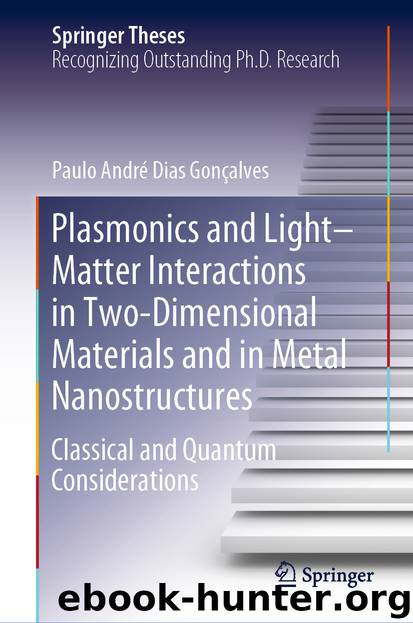Plasmonics and Light–Matter Interactions in Two-Dimensional Materials and in Metal Nanostructures by Paulo André Dias Gonçalves

Author:Paulo André Dias Gonçalves
Language: eng
Format: epub
ISBN: 9783030382919
Publisher: Springer International Publishing
The computed dispersion relation of graphene plasmons guided along the apex of different triangular wedges and grooves is shown in Fig. 5.3. The spectrum contains a discrete set of well-defined eigenmodes, whose number depends on the opening angle (indicated in the insets). Moreover, the figure plainly shows that, for the same frequency, smaller angles yield correspondingly larger plasmon wavevectors, which is an indication of stronger field confinement near the apex of sharper wedges (or grooves). In addition, notice the large distance between the dispersion of the WGPs and GGPs eigenmodes and the light line in the dielectric (which is almost vertical and extremely close to the y-axis). This fact reflects the extremely high field localization provided by the aforementioned eigenmodes, which push further graphene’s capability of rendering plasmons that are deeply subwavelength. On a side note, this also justifies the high accuracy of our nonretarded framework, as retardations effects are negligible.
Furthermore, note the outstanding agreement between the semi-analytical theory detailed above and the electrodynamic simulations performed using the finite-element method (FEM) technique (whose data is depicted in the figure as colored symbols). This constitutes further evidence of the ability of our semi-analytic method to render accurate results, and at the same time it provides a deeper and more transparent fundamental understanding of the scaling properties of WGPs and GGPs.
Strikingly, the results plotted in Fig. 5.3 also convey a stark contrast between the dispersion curves akin to WGPs and GGPs, demonstrating the superiority of the former in squeezing light below the diffraction limit (because they attain larger wavevectors for the same angle of the structure). We further note that one can transform a wedge into a groove and vice-versa either by swapping the values of and , or by applying the angular transformation (this essentially interchanges the Green’s functions and ). For the sake of completeness, in Fig. 5.3f we have portrayed the spectrum of GPs guided along a triangular channel embedded in a homogeneous dielectric medium with the same average relative permittivity as its wedge and groove counterparts shown in the figure. It can be observed that—for the same angle—each of the modes attain increasingly larger wavevectors as we move from a groove, embedded, and wedge configuration (in this order). This observation hints us that the ability to reach deep subwavelength regimes strongly depends on the ratio, for a fixed (acute) angle. Such an educated guess is supported by the data shown in Fig. 5.4, where it can be observed that the geometrical scaling factor entering in Eq. (5.6) decreases monotonically with increasing . In turn, this translates into higher effective indexes, , for larger quotients . As an example, at a frequency of , the fundamental WGP eigenmode in Fig. 5.3b exhibits an effective index of . This already large effective index increases even further at higher frequencies (for instance, for the CO laser wavelength of (around 28.3 THz) this value climbs to ).
Fig. 5.4Dependence of the scaling factor , for eigenvalues associated with the fundamental mode, as a function of the ratio .
Download
This site does not store any files on its server. We only index and link to content provided by other sites. Please contact the content providers to delete copyright contents if any and email us, we'll remove relevant links or contents immediately.
The Complete Stick Figure Physics Tutorials by Allen Sarah(7135)
Secrets of Antigravity Propulsion: Tesla, UFOs, and Classified Aerospace Technology by Ph.D. Paul A. Laviolette(4974)
Thing Explainer by Randall Munroe(3782)
The River of Consciousness by Oliver Sacks(3412)
The Order of Time by Carlo Rovelli(3072)
How To by Randall Munroe(2911)
I Live in the Future & Here's How It Works by Nick Bilton(2839)
A Brief History of Time by Stephen Hawking(2819)
What If?: Serious Scientific Answers to Absurd Hypothetical Questions by Randall Munroe(2542)
The Great Unknown by Marcus du Sautoy(2532)
Midnight in Chernobyl by Adam Higginbotham(2384)
Blockchain: Ultimate Step By Step Guide To Understanding Blockchain Technology, Bitcoin Creation, and the future of Money (Novice to Expert) by Keizer Söze(2379)
Networks: An Introduction by Newman Mark(2264)
The Meaning of it All by Richard Feynman(2213)
Easy Electronics by Charles Platt(2204)
The Tao of Physics by Fritjof Capra(2162)
Midnight in Chernobyl: The Untold Story of the World's Greatest Nuclear Disaster by Adam Higginbotham(2074)
When by Daniel H Pink(2020)
Introducing Relativity by Bruce Bassett(2015)
